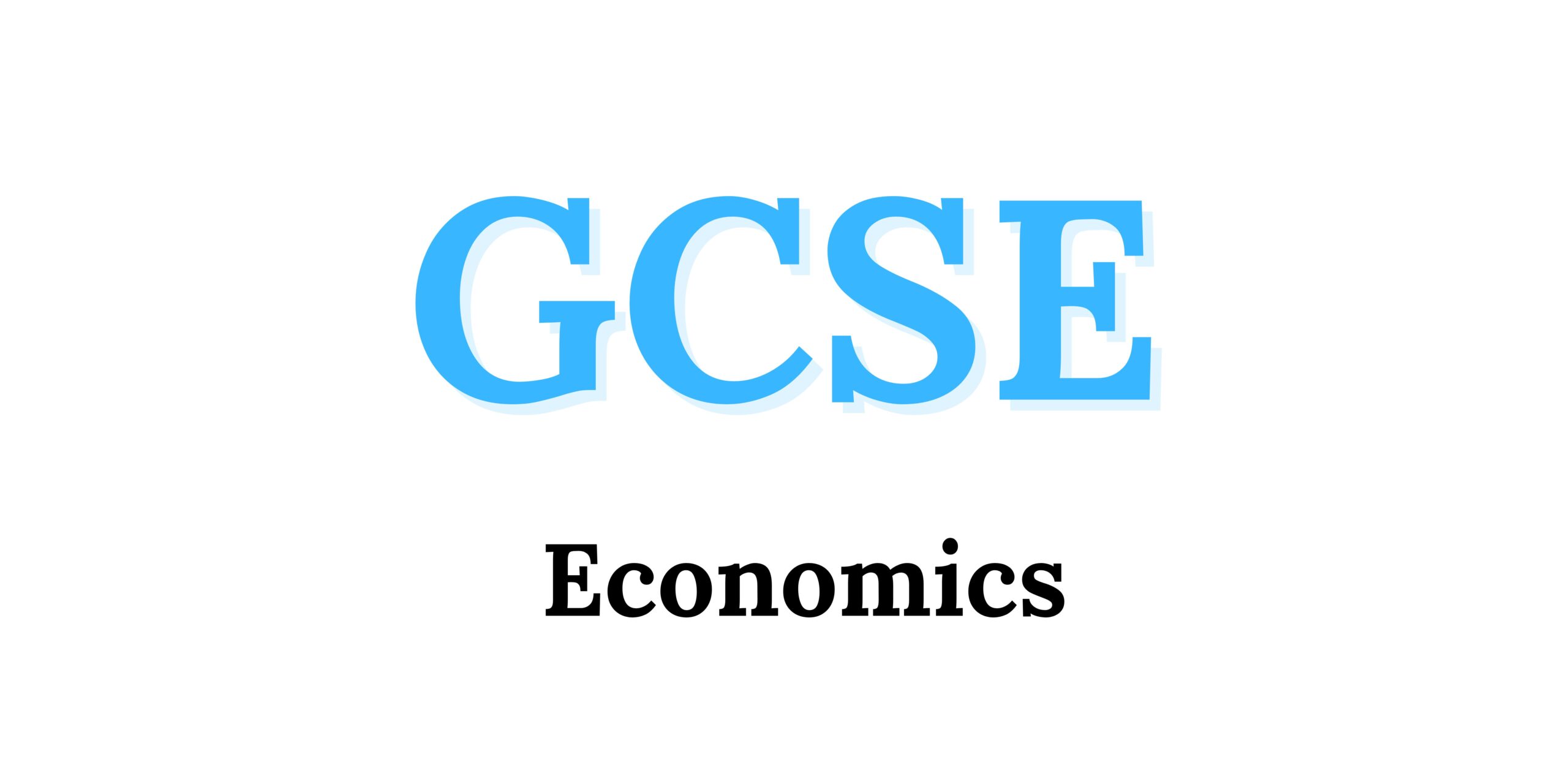
Overview of AQA GCSE Economics qualifications
Subject content:
How markets work
Students explore economic foundations, including resource allocation, price determination (supply, demand, elasticity), and concepts like costs, revenue, and economies of scale. They examine competition’s role in markets, causes of market failure, and the impact of externalities, with a focus on ethical and sustainability issues in economic decisions.
1. Economic foundations
| Topic | Content |
|---|---|
| Economic activity | • The primary purpose of economic activity • Key economic decision-making processes • Major economic groups |
| The factors of production | • Understand the nature of economic resources • The four factors of production (land, labor, capital and enterprise) and the rewards for each. |
| Making choices | • The basic economic problem • Costs and benefits of economic choices, including opportunity costs |
2. Resource allocation
| Topic | Content |
|---|---|
| Markets and allocation of resources | • Markets • Allocation of resources • Factor and product markets |
| Economic sectors | • Primary, secondary and tertiary sectors • Goods and services |
| Specialisation, division of labour, and exchange | The benefits and costs of specialization, division of labor, and exchange |
3. How prices are determined
| Topic | Content |
|---|---|
| Demand for goods and services | • Factors determining the demand for a good or service • Causes of changes in demand • The demand curve |
| Supply for goods and services | • Factors determining the supply of a good or service • Causes of changes in supply • The supply curve |
| Equilibrium price | • How equilibrium price is determined by supply and demand • How supply and demand diagrams illustrate a producer’s revenue |
| Intermarket relationships | • Complements and substitutes • How changes in one market can affect other markets |
| Price elasticity of demand | • Price elasticity of demand • Factors affecting price elasticity of demand • Measuring price elasticity of demand |
| Price elasticity of supply | • Price elasticity of supply • Factors affecting price elasticity of supply • Measuring price elasticity of supply |
4. Production, costs, revenue and profit
| Topic | Content |
|---|---|
| The importance of cost, revenue and profit for producers | • Business objectives • Types of costs and revenue • Profit • The importance of cost, revenue, and profit for producers • Moral and ethical considerations |
| Production and productivity | • The meaning and importance of productivity • Factors that influence productivity |
| Economies of scale | • The meaning of economies of scale • Types of economies of scale • Diseconomies of scale |
5. Competitive and concentrated markets
| Topic | Content |
|---|---|
| The importance of market structures on producers and consumers | • Identifying market structures • The range of market structures |
| Competitive markets | • Characteristics of a competitive market • Impact of competition on price, choice, producers, and consumers |
| Non-competitive markets | • Characteristics of a non-competitive market • Impact of non-competitive markets on price and choice • Monopoly and oligopoly |
| The labour market | • The role and functioning of the labor market • Wage determination through supply and demand • Gross vs. net pay |
6. Market failure
| Topic | Content |
|---|---|
| Misallocation of resources | • Market failure and misallocation of resources • Implications of resource misallocation • Government intervention |
| Externalities | • Defining externalities • Difference between positive and negative externalities |
How the economy works
Students explore the roles of consumers, producers, and government, focusing on interest rates, government objectives, and economic policies. They study the impact of trade, the global economy, free trade agreements, and the role of money and financial markets. Ethical and sustainability issues in economic management are also discussed.
7. Introduction to the national economy
| Topic | Content |
|---|---|
| Interest rates, saving, borrowing, spending and investment | • Interest rates • Impact of interest rates on consumers’ decisions to save, borrow, or spend • Impact of interest rates on producers’ decisions to save, borrow, or invest |
| Government income and expenditure | • UK government revenue and spending • Indirect and direct taxation • Progressive taxation |
8. Government objectives
| Topic | Content |
|---|---|
| Economic objectives of the government | • Main economic objectives of the government • Conflicts from pursuing these objectives • Other government objectives • Moral, ethical, and sustainability considerations |
| Economic growth | • Significance of economic growth to economies • Causes, costs, and benefits of economic growth • Government policies to promote economic growth |
| Employment and unemployment | • Employment and unemployment measurement • Types, causes, and consequences of unemployment • Government policies to reduce unemployment |
| Inflation and price stability | • What is inflation? • Measures of inflation • Causes and consequences of inflation • Government policies to manage inflation |
| Balance of payments | • Balance of trade and balance of payments • Surpluses and deficits on the current account • Government policies to influence the balance of payments |
| Distribution of income | • Income and wealth inequality • Causes and consequences of inequality • Government policies to redistribute income and wealth and their effects |
9. How the government manages the economy
| Topic | Content |
|---|---|
| Fiscal policy | • Fiscal policy • The government budget |
| Monetary policy | • Understanding monetary policy • Using monetary policy to control inflation • Using monetary policy to achieve other government economic objectives |
| Supply-side policies | • Advantages and disadvantages of supply-side policies • Key policies: education investment, lower taxes, trade union reform, privatization, deregulation • Using supply-side policies to achieve government objectives |
| Policies to correct positive and negative externalities | Government policies to address positive and negative externalities |
10. International trade and the global economy
| Topic | Content |
|---|---|
| Why countries trade and the importance of international trade to the UK | • Benefits of trade to countries • UK’s exports and imports |
| Exchange rates | • How exchange rates are determined • Effects of exchange rate changes on consumers and producers |
| Free-trade agreements including the European Union | • Free-trade • Free-trade agreements such as the EU |
| Globalisation: benefits and drawbacks | • Features of globalization • Benefits and drawbacks for producers, workers, and consumers in both developed and less developed countries • Ethical and sustainability considerations |
11. The role of money and financial markets
| Topic | Content |
|---|---|
| The role of money | • Functions of money • Definition of money |
| The role and importance of the financial sector for the economy | • The financial sector • The role of the Bank of England • The role of other financial institutions |
For detailed information about the General Certificate of Secondary Education (GCSE) and how it can shape your academic future, click here to explore: GCSE Information
Assessment
| Component | Content | Questions | Final score | Weighting of final grade |
|---|---|---|---|---|
| Paper 1: How markets work | Content 1 – 6. Students will be expected to draw on knowledge and understanding of the entire course of study to show a deeper understanding of these topics. | Section A: 10 multiple choice questions followed by a range of calculation, short and extended response questions. Section B: five questions involving a mix of calculations, short and extended responses. | 80 marks | 50% |
| Paper 2: How the economy works | Content 7–11. Students will be expected to draw on knowledge and understanding of the entire course of study to show a deeper understanding of these topics. | Section A: 10 multiple choice questions followed by a range of calculation, short and extended response questions. Section B: five questions involving a mix of calculations, short and extended responses. | 80 marks | 50% |
If you need help with Economics or any other subject, our tutors are ready to support you on your academic journey. Don’t miss your chance to succeed—take a trial lesson today!
Assessment objective weightings for GCSE Economics
Assessment Objectives:
AO1: Demonstrate knowledge and understanding of economic concepts and issues.
AO2: Apply knowledge and understanding to various contexts.
AO3: Analyse and evaluate economic evidence, make judgments, and draw conclusions.
| Assessment objectives (AOs)* | Component weightings Paper 1 (%) | Component weightings Paper 2 (%) | Overall weighting (approx %) |
|---|---|---|---|
| AO1 | 17.5 | 17.5 | 35 |
| AO2 | 17.5 | 17.5 | 35 |
| AO3 | 15 | 15 | 30 |
| Overall weighting of components | 50 | 50 | 100 |
Assessment weightings
Marks on the papers will be scaled to align with the component weightings. Final marks will be the sum of the scaled marks for each component. Grade boundaries will be determined based on this total scaled mark, as shown in the table below.
| Component | Maximum raw mark | Scaling factor | Maximum scaled mark |
|---|---|---|---|
| How markets work | 80 | x1 | 80 |
| How the economy works | 80 | x1 | 80 |
| Total scaled mark: | 160 |











